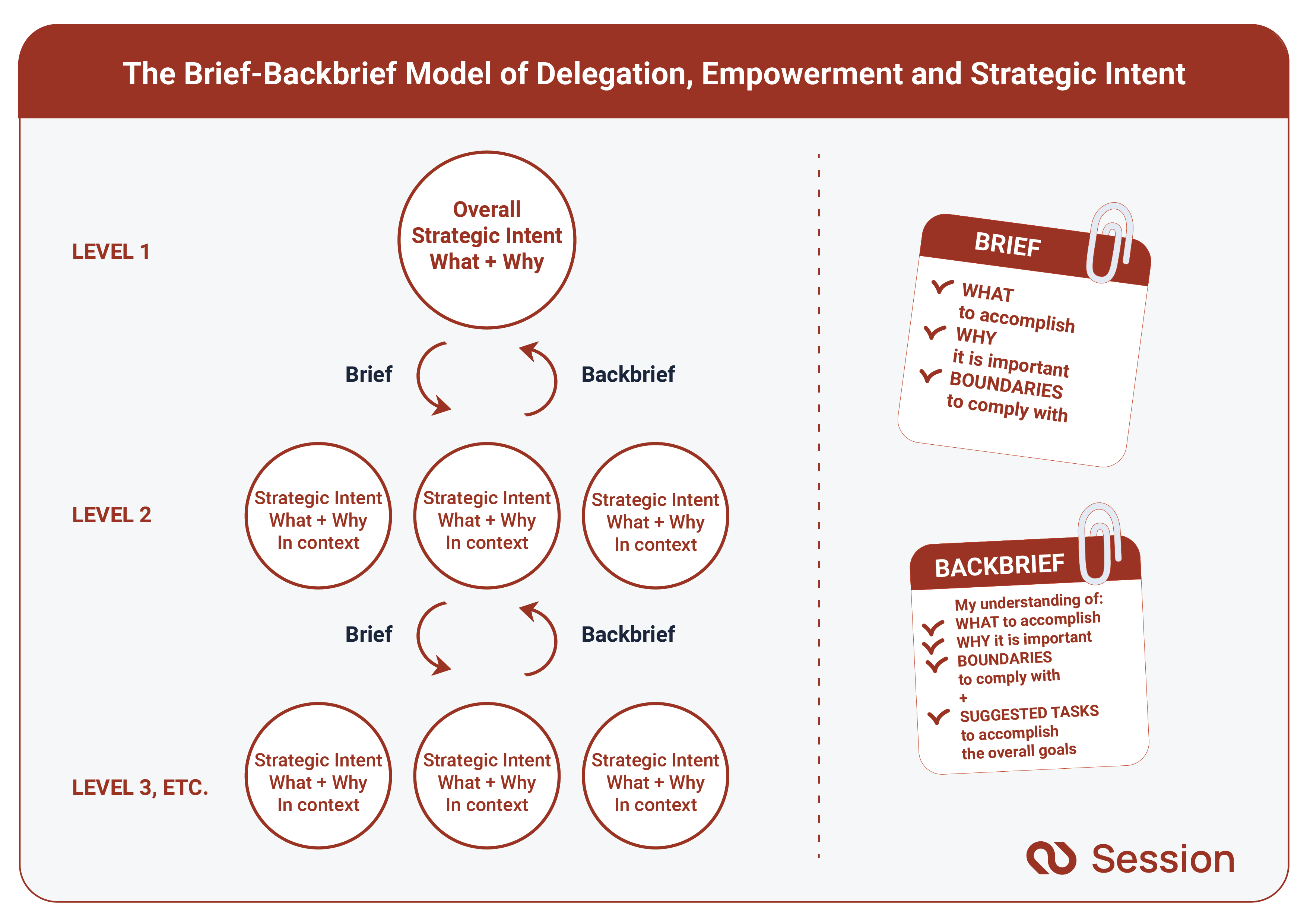The best managers know that they must delegate and empower their people to do a great job. Both in order to free up their time to focus on strategic priorities, but also in order to empower employees to feel autonomous, capable and supported throughout the process of accomplishing their goals. Yet, in reality, many leaders struggle to relinquish power and give responsibility to their employees, and they also struggle to find the time to truly develop and support people - which true empowerment is all about.
Delegation can be difficult because it ultimately requires trusting others and letting go of control - yet still being held accountable to answer for results. As a consequence, many leaders and managers tend to be too direct and give orders when they delegate, in order to make sure that things are done as intended. This is very often perceived by their direct reports as micromanaging, having little trust, and not having confidence in their employees to get the work done.
This leadership style is dangerous - it results in low employee morale, a work culture that lacks confidence, and managers that cannot see the big picture - because they are heavily burdened with an overstretched bandwidth. If this resonates with you, don’t despair - there are a number of ways that delegation can be effectively woven into the fabric of your organization’s culture and a number of ways to be better at truly empowering your workforce.
“View your leadership as being less about giving top-down orders and more about cultivating those who follow you, empowering them to make the right decisions. Many leaders are tempted to lead like a chess master, striving to control every move, when they should be leading like gardeners: creating and maintaining a viable ecosystem in which the organization operates.”, United States Army General Stanley McChrystal
The Benefits of Empowerment and Delegation
“The upper limit of what’s possible will increase only with each collaborator you empower to contribute their best work to your shared priorities. Likewise, your power decreases with every initiative you unnecessarily hold on to.”, Jesse Sostrin, Harvard Business Review
Empowerment yields countless benefits - from helping employees to be self-autonomous over their work, to enabling managers to focus on big-picture thinking and organizational strategy. Let’s examine some of the many benefits of empowerment and delegation:
1. Empowerment maximizes employee potential: Not only does the fact that employees are helped to do things themselves help free time for the manager to focus on the big-picture and strategic thinking and goal setting - it also helps employees learn new skills. Empowered employees can broaden their skill sets and maximize their potential for learning new skills.
2. Empowerment creates space for new ideas: When managers are left to deal with all of the details of a project and fail to delegate and empower, it will be difficult to find time for higher-level thinking and they will also be missing out on important perspectives, ideas and inputs from employees. Delegating gives managers more space for forward-thinking, and empowerment brings the employees into the equation, which will propel the department, team and even company into the right direction.
3. Empowerment improves employee job satisfaction: Studies point to the relationship between delegation and overall employee job satisfaction as well as the relationship between empowerment and engagement. It should come as no surprise, since being able to use ones skills to the fullest (through having work tasks properly delegated) as well as being listened to, taken seriously and into consideration is something anyone strives for and thrives with.
4. Empowerment helps your employees as well as the organization to grow: When work is delegated throughout the organization, an opportunity to develop and grow individuals as well as the company arises. Through empowerment, you can develop new departments or divisions within the company. This helps your company expand both vertically and horizontally.
5. Empowerment and delegation is the key to working smarter. In fact, according to Gallup, CEOs who excel in delegating generate 33% higher revenue. Imagine the effects on your bottom line if managers at every level empowered and delegated well.
Yet, at countless organizations, managers and leaders struggle to recognize the power of empowerment and delegation and reap its rewards. Why exactly is empowerment and delegation so difficult? In the next paragraph, I will discuss the reasons in more detail.
Why Is Empowerment and Delegation So Difficult?
The difficulty of delegation centers around trust - ultimately, it requires a high degree of trust among others. Trust doesn’t come naturally to everyone, and it’s particularly hard for managers to build it when they are overloaded already. Let’s take a look at the following commonly found excuses that managers use when it comes to the lack of empowering and delegating tasks:
- “It’s faster if I just do it myself.”
- “Other people can’t do it as well as I do.”
- “I don’t have anyone else available to do it.”
- “I don’t trust the person to be able to do it well on his/her own.”
Do any of these excuses sound familiar to you? If so, you may be wasting your time on low-value activities, making life harder for yourself and ultimately running the risk of becoming stressed, burnout, and potentially hurting your organization's potential to scale.
The trust factor can be extremely challenging, particularly in organizations that are highly performance-driven, with multiple KPIs that need to be hit on a recurring basis. This can result in managerial bottlenecks and a lack of agility and adaptability. Mid-managers and executives tend to get particularly stuck, because they have too much work and often fail to delegate to those different from themselves - which equates to a narrow perspective and vision.
Often, when managers are behind with their work, they tend to put more and more work hours in - from checking emails first thing in the morning, to catching up with work late in the evenings or at the weekend - instead of taking the time to empower and delegate (which in the long run would save them time!). As a result, they are always ‘’switched on’’ - in the operational, safe mode - which is avoidant of risks. This is not where creativity, forward-thinking or boldness exists. Without effective empowerment and delegation, managers can face burnout, small-picture thinking, lack of vision - not to mention face the fact that they are missing out on great development opportunities for their employees!
The Hidden Biases of Empowerment and Delegation
Even when empowerment and delegation takes place, there are a number of biases that can come to the fore, including racial and gender bias, as documented in a study published by the Journal of Experimental Social Psychology. According to this study, people have a tendency to delegate to people who think, act, and even look like them, as this feels more psychologically secure. As a result, managers often delegate to a small group of like-minded people. For managers in particular, one of the most relevant types of bias is similarity bias.
According to SHRM, similarity bias is the following feeling: ‘’People like me are better than others. The "people like me" similarities may range from ethnic background, religion, race, hobbies and economic class to professional approach and personality types.’’
This bias can be a threat to the overall organization: it brings about narrow perspectives, and also can isolate the rest of the group who may feel left out, disengaged, and in some cases - discriminated against, when they are not empowered or nothing is delegated to them.
So, how do we mitigate the risks of similarity bias? Seeking out different perspectives to ours is essential. Managers can reduce similarity bias by empowering and delegating tasks (where appropriate) to employees who differ significantly from them - and this is particularly important when it comes to race, ethnicity, gender, and economic background. At an organizational level, companies can also seek professional unconscious bias training, ensure that effective and tangible DEI measures are in place, and make inclusive hiring processes and procedures.
An Effective Approach to Finally Start Empowering and Delegating
Times are changing. At an organizational level, employees are demanding more than just a job. Employees want respect, a strong company culture, and the ability to partake in decisions and not be left sitting at the sidelines. The employee mindset which once echoed sentiments such as ‘’I’m just happy to have a job’’, has now shifted to an entirely different approach more in line with “I will work here only for as long as I find it meaningful and for as long as the role helps me grow as a professional”.
In other words: employees now want to be part of the decision making process, be listened to, and to get opportunities to learn and grow: ‘’How can I learn and grow in my current role? How can I contribute to the organization? Am I being taken seriously and listened to?’’ With this now becoming the rule rather than the exception, top-down leadership practices are becoming increasingly outdated. Employer decision-making needs to be taken to the front line - by empowering and delegating. This way you will not only get an employee who helps you get things done more efficiently, you will also build up a culture of learning in general, to the benefit of you and the organization.
Delegation shouldn’t just be instructional - ‘’please get this job done’. It should be empowering - ‘’We need this job done, find a way of how to do it, and I’ll support you along the way”.
Introducing the Brief-Backbrief Model
When managers are reluctant to empower their people, it is, as previously discussed, because it is like taking the risk of things going in different directions. However, more often, things are going in different directions because managers are not clear about what they want done and why it’s important. The process of giving instructions often leaves a significant amount of room for misinterpretation. Often, instructions are vague or abstract, people might become distracted during the briefing, or the recipient may just make some different assumptions than the person delivering the instructions.
Let’s take a look at how you can actually empower your people effectively without taking the risk of things going in the wrong direction, by introducing the Brief-Backbrief Model, inspired by Stephen Bungay. The Brief-Backbrief Model is an effective tool to manage expectations, and thereby both set a clear direction of what needs to be accomplished while at the same time give autonomy for employees to find the right solutions for themselves.
With the Brief-Backbrief Model, the manager makes a brief about what is needed to get accomplished, and the employee then responds with a backbrief, describing how s/he wishes to accomplish it. The crucial part is that the manager doesn’t give an instruction about what s/he wants the employee to do, but a brief about what s/he wants accomplished. This subtle difference between “what I want you to do '' and “what I want you to accomplish” makes it possible to set a direction without telling people what to do.
However, the manager also needs to communicate why it is important. Humans are a meaning-making species. When we understand why something is important we can put the task into context, which enables us to become more creative and solve the task in the best way possible. So, when you are NOT telling people WHAT TO DO, you need to tell people WHAT CANNOT HAPPEN, that is: What are the boundaries. It could be something in line with “you need to do it within our budget” or “it needs to be done by Tuesday” or “it cannot compromise our quality standards”,etc.
Consequently, a good brief covers:
- What do we need to accomplish?
- Why is it important?
- What are the boundaries?
The employee then delivers a backbrief (after having had a chance to think it through), covering:
- What we need to accomplish
- Why it is important
- What are the boundaries
- How I suggest to solve it
This simple routine helps to solidify expectations and make sure we are solving the right tasks. It also helps leaders to get feedback on how precise their communication is.
The person giving the brief can then determine whether the message was received properly or if further clarification is needed. If the repeated version is not the same as the original intent, the brief needs to be clarified and talked about further. This method helps to empower the employee without the manager giving up all control. But it doesn’t stop here. The model also allows for reflection throughout and after task completion: What did the employee do? Learn? Reflect upon?
Empowerment As Strategy Execution
In Stephen Bungay’s HBR article: How to Make the Most of Your Company’s Strategy, Bungay points to the power of effective briefing as a means to unlock hidden sources of productivity, and to ensure that the people in your company are both strategically aligned and operationally autonomous. This method of empowerment and delegation has served high-performance organizations for 2,000 years, with an impressive history tracing back to the Roman army, military practices throughout NATO, and was also used in 19th-century Prussian army, enabling forces to cope with the fast-changing uncertainties of warfare.
Considering the unpredictable and volatile nature of today’s business environment, companies who adopt such approaches are more likely to future-proof their strategy. Through strategy briefing, a five-step approach is implemented that can be applied from top management to the frontline people. It provides a way for managers and employees to move from confusion around a complex set of goals and measures to clarity around which objectives each person needs to focus on and when. Furthermore, it pushes decision making to the frontline, strengthening adaptability, building commitment and ensuring alignment.
The steps are as follows:
(1) state your intent, or what you want to accomplish and why,
(2) revise it in the context of the situation of your company or division
(3) determine which measures best indicate whether you’re achieving your goal,
(4) define the tasks implied by your intent, and
(5) define the boundaries, or constraints, actions and decisions need to happen within
In the figure below I have visualized the process, which I hope you will find useful:

Illustration inspired by Stephen Bungay, made by Henrik Kongsbak, illustrated by Agnieszka Ewa
Conclusion
Empowerment and delegation does not just do good for your employees and your organization, it also does good for yourself - by taking unnecessary weight off your shoulders. Empowerment yields countless benefits - from helping employees to be self-autonomous over their work, to enabling managers to focus on big-picture thinking and organizational strategy. However, it is important to recognize that empowerment and delegation is not easily implemented and comes with the risk of certain pitfalls - like bias in the empowerment and delegation process. Add to this the difficulty for some managers in relinquishing control, it is no easy feat. With the suggestions above, I hope you are ready to start empowering and delegating more - resulting in happier and more engaged employees, big picture thinking, and ultimately, a forward-thinking and healthy organization.










